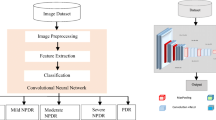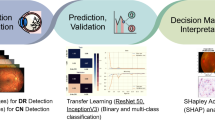Abstract
Propose
The proposed deep learning model with a mask region-based convolutional neural network (Mask R-CNN) can predict choroidal thickness automatically. Changes in choroidal thickness with age can be detected with manual measurements. In this study, we aimed to investigate choroidal thickness in a comprehensive aspect in healthy eyes by utilizing the Mask R-CNN model.
Methods
A total of 68 eyes from 57 participants without significant ocular disease were recruited. The participants were allocated to one of three groups according to their age and underwent spectral domain optical coherence tomography (SD-OCT) or enhanced depth imaging OCT (EDI-OCT) centered on the fovea. Each OCT sequence included 25 slices. Physicians labeled the choroidal contours in all the OCT sequences. We applied the Mask R-CNN model for automatic segmentation. Comparisons of choroidal thicknesses were conducted according to age and prediction accuracy.
Results
Older age groups had thinner choroids, according to the automatic segmentation results; the mean choroidal thickness was 253.7 ± 41.9 μm in the youngest group, 206.8 ± 35.4 μm in the middle-aged group, and 152.5 ± 45.7 μm in the oldest group (p < 0.01). Measurements obtained using physician sketches demonstrated similar trends. We observed a significant negative correlation between choroidal thickness and age (p < 0.01). The prediction error was lower and less variable in choroids that were thinner than the cutoff point of 280 μm.
Conclusion
By observing choroid layer continuously and comprehensively. We found that the mean choroidal thickness decreased with age in healthy subjects. The Mask R-CNN model can accurately predict choroidal thickness, especially choroids thinner than 280 μm. This model can enable exploring larger and more varied choroid datasets comprehensively, automatically, and conveniently.




Similar content being viewed by others
References
Linsenmeier RA, Padnick-Silver L (2000) Metabolic dependence of photoreceptors on the choroid in the normal and detached retina. Invest Ophthalmol Vis Sci 41:3117–3123
Parver LM, Auker C, Carpenter DO (1980) Choroidal blood flow as a heat dissipating mechanism in the macula. Am J Ophthalmol 89:641–646. https://doi.org/10.1016/0002-9394(80)90280-9
Grossniklaus HE, Green WR (2004) Choroidal neovascularization. Am J Ophthalmol 137:496–503. https://doi.org/10.1016/j.ajo.2003.09.042
Spaide RF, Hall L, Haas A et al (1996) Indocyanine green videoangiography of older patients with central serous chorioretinopathy. Retina Phila Pa 16:203–213. https://doi.org/10.1097/00006982-199616030-00004
Flitcroft DI, He M, Jonas JB et al (2019) IMI: defining and classifying myopia: a proposed set of standards for clinical and epidemiologic studies. Invest Ophthalmol Vis Sci 60:M20–M30. https://doi.org/10.1167/iovs.18-25957
Gomi F, Tano Y (2008) Polypoidal choroidal vasculopathy and treatments. Curr Opin Ophthalmol 19(3):208–212. https://doi.org/10.1097/ICU.0b013e3282fb7c33
Cheung CMG, Lee WK, Koizumi H et al (2019) Pachychoroid disease. Eye 33:14–33. https://doi.org/10.1038/s41433-018-0158-4
Wakatsuki Y, Shinojima A, Kawamura A, Yuzawa M (2015) Correlation of aging and segmental choroidal thickness measurement using swept source optical coherence tomography in healthy eyes. PLoS One 10:e0144156. https://doi.org/10.1371/journal.pone.0144156
Entezari M, Karimi S, Ramezani A et al (2018) Choroidal thickness in healthy subjects. J Ophthalmic Vis Res 13:39–43. https://doi.org/10.4103/jovr.jovr_148_16
Ding X, Li J, Zeng J et al (2011) Choroidal thickness in healthy chinese subjects. Invest Ophthalmol Vis Sci 52:9555–9560. https://doi.org/10.1167/iovs.11-8076
Tian J, Marziliano P, Baskaran M et al (2013) Automatic segmentation of the choroid in enhanced depth imaging optical coherence tomography images. Biomed Opt Express 4:397–411. https://doi.org/10.1364/BOE.4.000397
Masood S, Fang R, Li P et al (2019) Automatic choroid layer segmentation from optical coherence tomography images using deep learning. Sci Rep 9:3058. https://doi.org/10.1038/s41598-019-39795-x
He F, Chun RKM, Qiu Z et al (2021) Choroid segmentation of retinal OCT images based on CNN classifier and l2-lq fitter. Comput Math Methods Med 2021:8882801. https://doi.org/10.1155/2021/8882801
He K, Gkioxari G, Dollar P, Girshick R (2017) Mask R-CNN. pp 2961–2969
Hsia WP, Tse SL, Chang CJ, Huang YL (2021) Automatic segmentation of choroid layer using deep learning on spectral domain optical coherence tomography. Appl Sci 11:5488. https://doi.org/10.3390/app11125488
Ikuno Y, Kawaguchi K, Nouchi T, Yasuno Y (2010) Choroidal thickness in healthy Japanese subjects. Invest Ophthalmol Vis Sci 51:2173–2176. https://doi.org/10.1167/iovs.09-4383
Kim M, Kim SS, Koh HJ, Lee SC (2014) Choroidal thickness, age, and refractive error in healthy Korean subjects. Optom Vis Sci Off Publ Am Acad Optom 91:491–496. https://doi.org/10.1097/OPX.0000000000000229
Russell BC, Torralba A, Murphy KP, Freeman WT (2005) LabelMe: a database and web-based tool for image annotation. Int J Comput Vis 77(1):157–173
Fujiwara A, Shiragami C, Shirakata Y et al (2012) Enhanced depth imaging spectral-domain optical coherence tomography of subfoveal choroidal thickness in normal Japanese eyes. Jpn J Ophthalmol 56:230–235. https://doi.org/10.1007/s10384-012-0128-5
Chhablani J, Rao PS, Venkata A et al (2014) Choroidal thickness profile in healthy Indian subjects. Indian J Ophthalmol 62:1060–1063. https://doi.org/10.4103/0301-4738.146711
Akay F, Gundogan FC, Yolcu U et al (2016) Choroidal thickness in systemic arterial hypertension. Eur J Ophthalmol 26:152–157. https://doi.org/10.5301/ejo.5000675
Shao L, Zhou LX, Xu L, Wei WB (2021) The relationship between subfoveal choroidal thickness and hypertensive retinopathy. Sci Rep 11:5460. https://doi.org/10.1038/s41598-021-84947-7
Lee HK, Lim JW, Shin MC (2013) Comparison of choroidal thickness in patients with diabetes by spectral-domain optical coherence tomography. Korean J Ophthalmol 27:433–439. https://doi.org/10.3341/kjo.2013.27.6.433
Abadia B, Suñen I, Calvo P et al (2018) Choroidal thickness measured using swept-source optical coherence tomography is reduced in patients with type 2 diabetes. PLoS One 13:e0191977. https://doi.org/10.1371/journal.pone.0191977
Spaide RF, Koizumi H, Pozzoni MC, Pozonni MC (2008) Enhanced depth imaging spectral-domain optical coherence tomography. Am J Ophthalmol 146:496–500. https://doi.org/10.1016/j.ajo.2008.05.032
Kong M, Choi DY, Han G et al (2018) Measurable range of subfoveal choroidal thickness with conventional spectral domain optical coherence tomography. Transl Vis Sci Technol 7:16. https://doi.org/10.1167/tvst.7.5.16
Zhao J, Wang YX, Zhang Q et al (2018) Macular choroidal small-vessel layer, sattler’s layer and haller’s layer thicknesses: the Beijing eye study. Sci Rep 8:4411. https://doi.org/10.1038/s41598-018-22745-4
Mansouri K, Medeiros FA, Marchase N et al (2013) Assessment of choroidal thickness and volume during the water drinking test by swept-source optical coherence tomography. Ophthalmology 120:2508–2516. https://doi.org/10.1016/j.ophtha.2013.07.040
Marneros AG, Fan J, Yokoyama Y et al (2005) Vascular endothelial growth factor expression in the retinal pigment epithelium is essential for choriocapillaris development and visual function. Am J Pathol 167:1451–1459. https://doi.org/10.1016/S0002-9440(10)61231-X
Blaauwgeers HGT, Holtkamp GM, Rutten H et al (1999) Polarized vascular endothelial growth factor secretion by human retinal pigment epithelium and localization of vascular endothelial growth factor receptors on the inner choriocapillaris: evidence for a trophic paracrine relation. Am J Pathol 155:421–428. https://doi.org/10.1016/S0002-9440(10)65138-3
Ramrattan RS, van der Schaft TL, Mooy CM et al (1994) Morphometric analysis of Bruch’s membrane, the choriocapillaris, and the choroid in aging. Invest Ophthalmol Vis Sci 35:2857–2864
Foo VHX, Gupta P, Nguyen QD et al (2020) Decrease in choroidal vascularity index of Haller’s layer in diabetic eyes precedes retinopathy. BMJ Open Diabetes Res Care 8:e001295. https://doi.org/10.1136/bmjdrc-2020-001295
Esmaeelpour M, Ansari-Shahrezaei S, Glittenberg C et al (2014) Choroid, haller’s, and sattler’s layer thickness in intermediate age-related macular degeneration with and without fellow neovascular eyes. Invest Ophthalmol Vis Sci 55:5074–5080. https://doi.org/10.1167/iovs.14-14646
Dhoot DS, Huo S, Yuan A et al (2013) Evaluation of choroidal thickness in retinitis pigmentosa using enhanced depth imaging optical coherence tomography. Br J Ophthalmol 97:66–69. https://doi.org/10.1136/bjophthalmol-2012-301917
Ouyang Y, Heussen FM, Mokwa N et al (2011) Spatial distribution of posterior pole choroidal thickness by spectral domain optical coherence tomography. Invest Ophthalmol Vis Sci 52:7019–7026. https://doi.org/10.1167/iovs.11-8046
Hirata M, Tsujikawa A, Matsumoto A et al (2011) Macular choroidal thickness and volume in normal subjects measured by swept-source optical coherence tomography. Invest Ophthalmol Vis Sci 52:4971–4978. https://doi.org/10.1167/iovs.11-7729
Chhablani J, Barteselli G, Wang H et al (2012) Repeatability and reproducibility of manual choroidal volume measurements using enhanced depth imaging optical coherence tomography. Invest Ophthalmol Vis Sci 53:2274–2280. https://doi.org/10.1167/iovs.12-9435
Hwang S, Kong M, Song Y-M, Ham D-I (2020) Choroidal spatial distribution indexes as novel parameters for topographic features of the choroid. Sci Rep 10:574. https://doi.org/10.1038/s41598-019-57211-2
Copete S, Flores-Moreno I, Montero JA et al (2014) Direct comparison of spectral-domain and swept-source OCT in the measurement of choroidal thickness in normal eyes. Br J Ophthalmol 98:334–338. https://doi.org/10.1136/bjophthalmol-2013-303904
Lee M-W, Park H-J, Shin Y-I et al (2020) Comparison of choroidal thickness measurements using swept source and spectral domain optical coherence tomography in pachychoroid diseases. PLoS One 15:e0229134. https://doi.org/10.1371/journal.pone.0229134
Fujiwara T, Imamura Y, Margolis R et al (2009) Enhanced depth imaging optical coherence tomography of the choroid in highly myopic eyes. Am J Ophthalmol 148:445–450. https://doi.org/10.1016/j.ajo.2009.04.029
Agrawal R, Gupta P, Tan K-A et al (2016) Choroidal vascularity index as a measure of vascular status of the choroid: Measurements in healthy eyes from a population-based study. Sci Rep 6:21090. https://doi.org/10.1038/srep21090
Iovino C, Pellegrini M, Bernabei F et al (2020) Choroidal Vascularity index: an in-depth analysis of this novel optical coherence tomography parameter. J Clin Med 9:595. https://doi.org/10.3390/jcm9020595
Funding
All authors have no relevant financial or non-financial interests to disclose. No funding was received for conducting this study.
Author information
Authors and Affiliations
Corresponding author
Ethics declarations
Conflict of interest
All authors declare that they have no affiliations with or involvement in any organization or entity with any financial interest (such as honoraria, educational grants, or participation in speakers’ bureaus) or non-financial interest (such as personal or professional relationships, affiliations, knowledge, or beliefs) in the subject matter or materials discussed in this manuscript.
Ethical approval
Approval was obtained from the Institutional Review Board (IRB) of Taichung Veteran General Hospital with case number: CE21201B. All procedures performed in this study involving human participants were in accordance with the ethical standards of IRB of Taichung Veteran General Hospital and with the 1964 Helsinki declaration and its later amendments or comparable ethical standards.
Informed consent
It is not necessary to obtain consent. Informed consent was granted exemption by ethical research committee of Taichung Veteran General Hospital. Images applied in the study were OCT sequence, which could be completely anonymized. The submission does not include information that may identify the participant.
Additional information
Publisher's Note
Springer Nature remains neutral with regard to jurisdictional claims in published maps and institutional affiliations.
Rights and permissions
About this article
Cite this article
Lin, C.Y., Huang, Y.L., Hsia, W.P. et al. Correlation of choroidal thickness with age in healthy subjects: automatic detection and segmentation using a deep learning model. Int Ophthalmol 42, 3061–3070 (2022). https://doi.org/10.1007/s10792-022-02292-8
Received:
Accepted:
Published:
Issue Date:
DOI: https://doi.org/10.1007/s10792-022-02292-8




